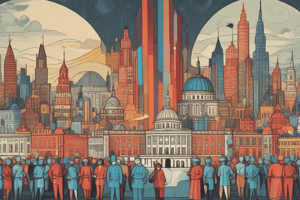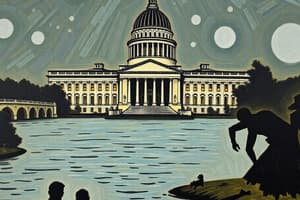Podcast
Questions and Answers
Which constitutional clause is primarily responsible for the establishment of the United States bureaucracy?
Which constitutional clause is primarily responsible for the establishment of the United States bureaucracy?
- The Commerce Clause
- The Equal Protection Clause
- The Necessary and Proper Clause (correct)
- The Supremacy Clause
What is the primary role of independent regulatory commissions within the bureaucracy?
What is the primary role of independent regulatory commissions within the bureaucracy?
- To advise the President on policy matters.
- To represent the interests of specific industries in government policymaking.
- To provide services that could be delivered by the private sector.
- To enforce rules and resolve disputes related to federal regulations. (correct)
Which of the following is NOT a characteristic of independent executive agencies?
Which of the following is NOT a characteristic of independent executive agencies?
- They are usually appointed by the President with Senate confirmation.
- They are not part of cabinet departments.
- They operate similarly to private businesses, providing services for a fee. (correct)
- They have a narrow focus and specific missions.
What is the term for the process by which the bureaucracy applies laws passed by Congress?
What is the term for the process by which the bureaucracy applies laws passed by Congress?
Which branch of government exercises the most control over the federal bureaucracy?
Which branch of government exercises the most control over the federal bureaucracy?
How does political patronage relate to the bureaucracy?
How does political patronage relate to the bureaucracy?
What is the source analysis skill highlighted in the text and how does it apply to the topic of the bureaucracy?
What is the source analysis skill highlighted in the text and how does it apply to the topic of the bureaucracy?
Which of the following is NOT a type of organization found within the United States bureaucracy?
Which of the following is NOT a type of organization found within the United States bureaucracy?
What is the primary role of the Civil Service Commission?
What is the primary role of the Civil Service Commission?
What is the main difference between the "iron triangle" and the "issue network"?
What is the main difference between the "iron triangle" and the "issue network"?
What is the main purpose of the "merit system"?
What is the main purpose of the "merit system"?
What is the primary function of the Senior Executive Service?
What is the primary function of the Senior Executive Service?
What is the concept of neutrality in the context of the bureaucracy?
What is the concept of neutrality in the context of the bureaucracy?
Which of the following is NOT a key factor in the decline of the "iron triangle"?
Which of the following is NOT a key factor in the decline of the "iron triangle"?
What is the primary role of bureaucracy in policy implementation?
What is the primary role of bureaucracy in policy implementation?
Which of the following best describes the "policy cycle"?
Which of the following best describes the "policy cycle"?
Which of the following is NOT a method Congress uses to hold the Bureaucracy accountable?
Which of the following is NOT a method Congress uses to hold the Bureaucracy accountable?
What is the main purpose of oversight hearings conducted by Congress?
What is the main purpose of oversight hearings conducted by Congress?
How does the President exert influence over the Bureaucracy?
How does the President exert influence over the Bureaucracy?
What is 'compliance monitoring' in the context of holding the Bureaucracy accountable?
What is 'compliance monitoring' in the context of holding the Bureaucracy accountable?
How does the public exert influence over the Bureaucracy?
How does the public exert influence over the Bureaucracy?
What is the primary function of the Government Accountability Office (GAO)?
What is the primary function of the Government Accountability Office (GAO)?
What are the four key components of a quantitative analysis Free Response Question (FRQ)?
What are the four key components of a quantitative analysis Free Response Question (FRQ)?
When analyzing a data set, what is the first step you should take?
When analyzing a data set, what is the first step you should take?
How can Congress check on the Bureaucracy?
How can Congress check on the Bureaucracy?
Which of these checks on the Bureaucracy is a power of the President?
Which of these checks on the Bureaucracy is a power of the President?
What is the primary difference between Congressional control and the Presidential control described in the text?
What is the primary difference between Congressional control and the Presidential control described in the text?
Which of these is NOT a way the Judicial Branch can check on the Bureaucracy?
Which of these is NOT a way the Judicial Branch can check on the Bureaucracy?
The text discusses the importance of 'implications' in analyzing political data. What is the best explanation for this emphasis?
The text discusses the importance of 'implications' in analyzing political data. What is the best explanation for this emphasis?
Flashcards
Bureaucracy
Bureaucracy
The system of government agencies and offices responsible for carrying out laws and regulations.
Necessary and Proper Clause
Necessary and Proper Clause
A constitutional clause allowing Congress to pass laws needed to carry out its powers.
Cabinet Departments
Cabinet Departments
Major organizations in the executive branch, each with broad responsibilities.
Independent Regulatory Commissions
Independent Regulatory Commissions
Signup and view all the flashcards
Government Corporations
Government Corporations
Signup and view all the flashcards
Independent Executive Agencies
Independent Executive Agencies
Signup and view all the flashcards
Quasi-legislative Activities
Quasi-legislative Activities
Signup and view all the flashcards
Checks and Balances
Checks and Balances
Signup and view all the flashcards
Merit System
Merit System
Signup and view all the flashcards
Civil Service Commission
Civil Service Commission
Signup and view all the flashcards
Neutrality in Bureaucracy
Neutrality in Bureaucracy
Signup and view all the flashcards
Senior Executive Service (SES)
Senior Executive Service (SES)
Signup and view all the flashcards
Iron Triangle
Iron Triangle
Signup and view all the flashcards
Issue Network
Issue Network
Signup and view all the flashcards
Policy Implementation
Policy Implementation
Signup and view all the flashcards
Policy Cycle
Policy Cycle
Signup and view all the flashcards
Policymaking Process
Policymaking Process
Signup and view all the flashcards
Linkage Institutions
Linkage Institutions
Signup and view all the flashcards
Checks on Bureaucracy
Checks on Bureaucracy
Signup and view all the flashcards
Judicial Review
Judicial Review
Signup and view all the flashcards
Quantitative Analysis FRQ
Quantitative Analysis FRQ
Signup and view all the flashcards
Enabling Legislation
Enabling Legislation
Signup and view all the flashcards
Bureaucratic Agencies
Bureaucratic Agencies
Signup and view all the flashcards
Oversight Hearings
Oversight Hearings
Signup and view all the flashcards
Power of the Purse
Power of the Purse
Signup and view all the flashcards
Presidential Influence
Presidential Influence
Signup and view all the flashcards
Compliance Monitoring
Compliance Monitoring
Signup and view all the flashcards
Public Comment Period
Public Comment Period
Signup and view all the flashcards
Study Notes
The Bureaucracy
- Originates from Article 1, Section 8 (Necessary and Proper Clause) and Article 2, Section 2 of the Constitution
- Includes cabinet departments (largest), independent regulatory commissions, government corporations, and independent executive agencies
- Independent regulatory commissions protect public interest and resolve disputes
- Government corporations operate like private businesses, often charging for services
- Independent executive agencies have narrower focus and specific missions
- Bureaucracy involved in quasi-legislative (rulemaking) and quasi-judicial (dispute resolution) activities
- Largely under executive control, but legislative and judicial branches also have influence
Bureaucracy Accountabiliy
- Political patronage was replaced by the merit system, rewarding based on qualifications through competitive exams
- The Civil Service Commission oversees and prohibits political-based job appointments, promotes fairness
- Iron triangles (bureaucratic agency, congressional committee, interest group) were previously common, but now issue networks are more common and are more flexible
- Several factors including numerous interest groups and subcommittees contributed to the decline of iron triangles
Bureaucracy Discretion and Rulemaking
- Policy implementation translates laws, policies, and executive orders into actionable rules
- Congress/President set general mandates and bureaucrats create specific guidelines and procedures to enact mandates
- This is part of a policy cycle that involves multiple steps: implementation, evaluation, problem definition, budget, agenda setting, etc.
- Congress delegates some implementation authority through enabling legislation
- Agencies use their technical expertise to complete these complex tasks
Holding Bureaucracy Accountable
- Congress, President, Bureaucracy, and Courts all implement and create possible policies
- Congress uses oversight hearings, the power of the purse, and the Government Accountability Office to exert influence
- Presidents use ideology, authority, and influence to affect the bureaucracy
- Bureaucracy checks itself through compliance monitoring
- Public input and comments provide feedback
Policy and Branches of Government
- All three branches check the bureaucracy
- Through actions such as Congressional appropriations, presidential appointments, judicial review and executive orders to implement or influence the bureaucracy
- Data analysis involves looking at trends, drawing conclusions, and examining implications in political contexts
Structure of the Bureaucracy
- Federal bureaucracy includes millions of people employed to carry out federal responsibilities
- 15 cabinet departments, agencies, independent regulatory commissions, and government corporations
- Agencies work together to achieve department goals
- Independent regulatory commissions are created to regulate aspects of society
- Government corporations provide services the government wants to offer to the public, often best provided through private methods
Bureaucratic Organizations (General)
- Bureaucratic organizations write, enforce, and issue fines for non-compliance of regulations
- Interact with Congress
- The federal bureaucracy is composed of millions of people across various agencies and departments
Branch Responsibilities (General)
- Legislative branch passes laws
- Judicial branch interprets laws
- Executive branch ensures people abide by laws
Delegated Discretionary Authority (General)
- No specific details were provided for this section
Studying That Suits You
Use AI to generate personalized quizzes and flashcards to suit your learning preferences.




